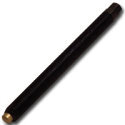OCD Solutions
Original, Clean and Dependable Solutions
- Location
- Rentz, GA
The instructions that came with my TBM Flywheel reccomended using one of these tools. I had to change out a Bendix this weekend and since I already had the tool I figured, why not finally try it? :dunno:
I have used the rope method before but more recently have been using an AC flywheel tool to hold the crank from spinning but this workd so slick I will def use it again.
I placed the piston at BDC and ran the tool in till only 2 threads were showing.
Why is everyone so scared to use these tools? I could see that if the bolt was seized on one could put more strain on the piston dome that it could handle or possibly bend a rod but I would think that for most cases this method would be very safe.
Anyways, what are your opinions? Anyone got a crappy engine we can experiment on to see how much force it takes to cause damage?
I have used the rope method before but more recently have been using an AC flywheel tool to hold the crank from spinning but this workd so slick I will def use it again.
I placed the piston at BDC and ran the tool in till only 2 threads were showing.
Why is everyone so scared to use these tools? I could see that if the bolt was seized on one could put more strain on the piston dome that it could handle or possibly bend a rod but I would think that for most cases this method would be very safe.
Anyways, what are your opinions? Anyone got a crappy engine we can experiment on to see how much force it takes to cause damage?

